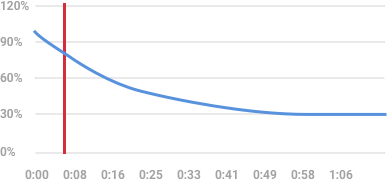Some marketers may have an unhealthy obsession with metrics — they track too many of them. Perhaps we think we could prove any marketing campaign is producing outcomes if there is an eye-catching percentage by its name. However, deep down, everyone knows that some metrics are more revealing than others. There are lots of KPIs that provide minimal insights. Luckily, although, we made this guide that will help you navigate YouTube Analytic and measure the metrics that actually matter. It will save you from drowning in the sea of Youtube analytic that most marketers only have a lifebuoy in, helping you not only stay afloat however swim safely to land.
Read on to learn about the YouTube analytic that actually matter, and the way they will improve your video strategy.
YouTube Analytic: The 15 Metrics That Actually Matter
1. Watch Time
Watch time is the total amount of minutes viewers have spent watching your videos. It is a key metric because YouTube elevates videos and channels with higher watch times in their search outcomes and suggestions section. YouTube does this because the more watch time a video has, the more engaging their algorithm presumes it’s.
In the watch time report, you could see the amount of watch time your videos have accumulated. You could also rank each of your videos by watch time and group your videos by themes, styles, and lengths to decide your most engaging kinds of videos.
2. Average Percentage Viewed
Average percentage seen is the % of each video the average viewer watched. It measures your video’s ability to hold viewers’ consideration for its entirety. And when YouTube realizes your videos could hold people’s attention, they will reward it with higher search and suggestion rankings. You could find this metric in your watch time report.
3. Average View Duration
Average view duration is the total watch time of your video divided by the total number of video plays, including replays. This metric measures your video’s ability to interact with viewers. In case your video cannot engage viewers, they will bounce from your video rapidly, leaving you with an unimpressive average view duration. But when your video could engage viewers, your average view duration and total watch time will enhance at the same time, boosting your search and suggestions rankings. You could also discover this metric in your watch time report.
4. Audience Retention
Audience retention shows you the percentage of viewers who watch and leave your video at every single moment of the video. YouTube elevates videos with high viewers retention in their search rankings and recommendations because these videos could effectively capture viewers’ attention.
Audience retention could also inform your future video strategy. The most engaging parts of your video might be your next greatest video topics. And watching your video during steep dips of engagement will let you know what may be boring your viewers, permitting you to scrap these elements from current and future videos.
In YouTube’s audience retention report, there shall be two graphs: the absolute retention curve and relative retention curve. The absolute retention curve shows you how well your videos retain viewers. And the relative retention shows you how well one of your videos retains viewers compared to all other YouTube videos of similar length.
Image Credit: YouTube
5. Re-watches
Re-watches are the number of times viewers re-watch certain parts of your video. If lots of people are re-watching a specific part of your video, then they are probably in the topic your video is covering during that moment. These topics could be fodder for your future video strategy. You could find this data in the absolute audience retention graph. Re-watches are often indicated by increasing curves in the graph.
Image Credit: YouTube
6. Engagement
Comments, shares, likes, and dislikes give marketers with lots of valuable qualitative data.
Comments could paint a clear image of your video’s emotional impact on viewers. Shares can gauge how much viewers worth your content and brand — since people share content that confirms their ideal self-persona, people who share your video are publicly displaying that they trust and support your brand. Likes and dislikes could help you decide what video topics work greatest with your specific audience. You could find your videos’ engagement metrics in YouTube’s Interactions Report.
7. Impressions Click-Through Rate
Impressions click-through rate measures your video’s ability to prompt people to watch your video after seeing it on their homepage, suggestion section, or trending section. A high click-through rate means your title was compelling and your video’s topic resonates with lots of related audiences on YouTube.
A common trend for impression click-through rates is that they often spike immediately after you release your video — your subscribers will see the video at the top of their home page and probably click on it. However, once your video spreads beyond your core audience, your click-through rate will decline and then stay at a stable rate.
You could also couple this metric with average percentage seen and average view duration to see if people actually watch your video after they click on it. A high click-through rate is nice, but when people are leaving right at the start of your video, your title or thumbnail can be misleading. Preparing viewers for what’s to come is essential because in case your title or thumbnail is inaccurate, they will feel deceived and lose trust in your brand.
A low click-through rate however high engagement can mean that the video has a small yet particular audience that’s enamored by the content. Go to the Youtube Analytic tab in YouTube Studio to examine this metric.
Image Credit: YouTube



-2.png)
.png)